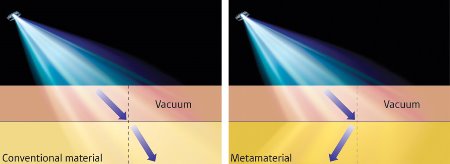Jul. 23, 2010 Research Highlight Physics / Astronomy
A trick of the light
Unusual properties predicted in superconducting thin films could deliver perfect lenses and other novel applications
 Figure 1: Schematic showing positive refraction (left) and negative refraction (right) of light in two types of materials (yellow). In conventional materials with a positive refractive index, light gets bent toward the normal axis. However, in negative refractive index materials, light gets bent the opposite way. © 2010 RIKEN (foreground) © 2010 iStockphoto/SKrow (background)
Figure 1: Schematic showing positive refraction (left) and negative refraction (right) of light in two types of materials (yellow). In conventional materials with a positive refractive index, light gets bent toward the normal axis. However, in negative refractive index materials, light gets bent the opposite way. © 2010 RIKEN (foreground) © 2010 iStockphoto/SKrow (background)
All known natural materials have a positive refractive index so that light that crosses from one medium to another gets slightly bent in the direction of propagation. In some artificial ‘metamaterial’ structures, however, negative refraction occurs such that light gets bent backwards as it enters the structure (Fig. 1). Thin films of high-temperature superconducting materials may achieve a similar effect according to new findings from researchers from the RIKEN Advanced Science Institute in Wako, and colleagues at the Ukrainian and Russian Academies of Sciences and Harvard University1,2.
The realization of metamaterials and their unusual optical properties has enabled a number of novel devices, including ‘invisibility cloaks’ that can completely conceal an object, as well as perfect lenses that can generate images of an object with arbitrary precision. However, there is a drawback with metamaterials explains Franco Nori from RIKEN and the University of Michigan, USA, who led the research team. “Typically, these metamaterials consist of complex metallic wires and other structures that require sophisticated fabrication technology and are difficult to assemble.”
In searching for alternative materials, Nori and his team turned to thin films of high-temperature superconducting materials. These materials crystallize in a pronounced layered structure, where superconductivity occurs only along specific atomic planes of the crystal. Beyond those planes these superconductors are insulating, so their electrical properties differ strongly between horizontal and vertical directions.
The researchers have now revealed how the layered structure of high-temperature superconductors affects the propagation of light. At certain wavelengths, electronic waves are known to be excited at the surface of the superconductor. While the existence of these surface waves is not unexpected, the researchers found that the surface waves cannot exist at some wavelengths in the far infrared (THz) part of the spectrum. “The particularities of the layered superconductor structure mean that, at these wavelengths, the structure shows a negative refractive index,” explains Boris Ivanov from RIKEN and the Ukrainian Academy of Sciences.
Although the behavior of these layered superconductors that have a negative refractive index is slightly different to the refractive properties of conventional metamaterials, they do represent a promising alternative to the complex device designs of metamaterials, says Valery Yampol’skii from RIKEN and the Ukrainian Academy of Sciences. Eventually, we may see perfect lenses or even more complex structures such as invisibility cloaks made from natural superconductors rather than from complicated artificial metamaterials, adds Nori.
References
- 1. Rakhmanov, A.L., Yampol’skii, V.A., Fan, J.A., Capasso, F. & Nori, F. Layered superconductors as negative-refractive-index metamaterials. Physical Review B 81, 075101 (2010). doi: 10.1103/PhysRevB.81.075101
- 2. Golick, V.A., Kadygrob, D.V., Yampol’skii, V.A., Rakhmanov, A.L., Ivanov, B.A. & Nori, F. Surface Josephson plasma waves in layered superconductors above the plasma frequency: evidence for a negative index of refraction. Physical Review Letters 104, 187003 (2010). doi: 10.1103/PhysRevLett.104.187003
